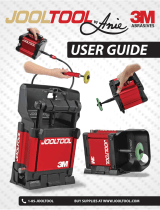Page is loading ...

RAZOR SHARP EDGEMAKING SYSTEM
RECOMMENDED SPEED - 3000 TO 3600 RPMs
Page Four
MANUFACTURED IN THE USA AND FULLY WARRANTED BY:
Razor Sharp Edgemaking System
26195 Otter DR
Willits, CA 95490-8046, USA
Web: www.sharpeningwheels.com
THE WARRANTY ON THIS PRODUCT IS COMPLETELY
UNCONDITIONAL AND FREE OF “RED TAPE”!
Should you find a manufacturing defect with one of our wheels
we will replace it free of charge or refund your purchase price,
including shipping.
CALL TOLL FREE: 1-866-419-4879
or 1-877-725-2197
IF YOU HAVE ANY PROBLEMS OR QUESTIONS ABOUT THIS
PRODUCT, PLEASE CONTACT THE MANUFACTURER,
TOLL FREE: 1-866-419-4879, FAX: 1-707-459-1541
E-MAIL: support@sharpeningwheels.com
CAUTION!:
ALWAYS USE
ANSI COMPLIANT EYE PROTECTION
and NEVER! - TURN THE CUTTING
EDGE INTO EITHER WHEEL
.
YES
NO!
You now have a great wheel for sharpening those
edges that are hard to get at! Please read the instructions
and feel free to call the makers, Razor Sharp Edgemaking
System at 1-866-419-4879, to discuss any questions or
problems that you may have!
This wheel will put a polished razor sharp edge on
your knives and tools in just seconds. Made to be used on a
bench grinder or buffer motor with 3000 RPMs or more, or
you may wish to mount the wheels on another device, such
as a belt driven mandrel.
RECOMMENDED SPEED - 3000 TO 3600 RPMs
Page One
07/12/2010
8X25X50SHPR
Brought to you by:
PLEASE READ THE INSTRUCTIONS!
Including the safety instructions on page four.
Phone: (800) 523-4777
Fax: (800) 438-5901
www.grizzly.com
Shaper Wheel
Grizzly Part # G5940

RAZOR SHARP EDGEMAKING SYSTEM
The wheel in this Kit is a called “SHAPER” because you can change the
shape of your wheel to make contact with the edge of a tool that you
simply cannot “get at” on the flat surface of a thicker wheel (or other
sharpening device).
To Shape Your Wheel:
60-grit sandpaper is recommended in re-shaping your wheel. Each user
can arrange and configure the wheel to sharpen his particular tool.
Grit Wheel:
Once your wheel is the correct shape you will be ready to apply the grit
(if necessary—sold separately). (NOTE: DO NOT apply the grit until your
wheel has been reshaped.) The black powder in the little jar in the Grit
Pack* is 180 Grit Silicon Carbide and can be applied to one or more
wheels. This can be done with the wheel mounted on a shaft or held on
a dowel or other device. First, put a thin layer of Elmer’s White Glue
(Ross’ in Canada) on the wheel, then either sprinkle the grit on the
wheel (if it is mounted) or roll it in a strip of Grit that you have placed in
the fold of a newspaper. (If the wheel is mounted, you will want a piece
of paper under it to catch what grit falls off.) Then let the grit dry on the
wheel for 10-12 hours before using.
When the wheel is both gritted and dried, rub a little of the yellow wax
(also found in the Grit Pack) on it for a lubricant, and you are ready to
sharpen! But be careful not to use too much wax, doing so will destroy
the effectiveness of the grit.
When re-gritting the wheel, use coarse sandpaper and get all the black
off, because the glue will not stick to the old wax and grit.
* Grizzly Industrial provides a Grit Pack (Stock #G5941) if grit is needed
to sharpen your particular tool.
Plain Wheel:
Once your wheel is shaped, place it on your bench grinder and turn it
on. Then, while the wheel is turning, before applying your tool, touch
the “cake” of white Jeweler’s Rouge to it. This allows you to hone & pol-
ish as you remove the burr from the cutting edge.
RECOMMENDED SPEED - 3000 TO 3600 RPMs
Page Two
RAZOR SHARP EDGEMAKING SYSTEM
RECOMMENDED SPEED - 3000 TO 3600 RPMs
Page Three
To Remove Burrs:
When you sharpen your tool, use the gritted wheel to develop a
little “burr” or “rollover”, then remove the burr on the plain wheel.
Sometimes the configuration of the tool is such that you can’t re-
move the burr on a wheel, then we recommend using a piece of
leather or such to hand-remove the burr. The tool surface that you
applied to the gritted wheel can also be polished on a plain wheel,
using the rouge to hone and polish.
Truing of wheel:
When you have the wheel running “true,” don’t remove them un-
necessarily, because when you put them back they will be in a dif-
ferent position and you may have to adjust them again. Some-
times, the wheels may be a little “out of round”. The grit wheel, out
of round, can be fixed when re-surfacing. If the plain wheel seems
out of round, it can be trued at any time with 60 grit sand paper.
Correcting out of roundness is easy. Take a piece of 60-grit sand-
paper and wrap it around a flat piece of metal (a flat file works
fine). Hold it lightly against the face of the wheel. You will feel the
“high” spot. Keep holding it lightly against the wheel until it feels
smooth. Now the “high” spot is gone.
/


